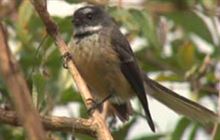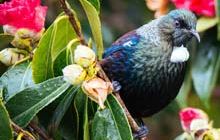Fantail/pīwakawaka
Introduction
Known for its friendly ‘cheet cheet’ call and energetic flying antics, the fantail is one of the most common and widely distributed native birds on the New Zealand mainland.New Zealand status: Endemic
Conservation status: North and South Island forms are Not Threatened, Chatham Island form is At Risk–Naturally Uncommon
Found in: Throughout New Zealand
Sound recordings:
Fantail: Chatham Island fantail song (MP3 1,597K)
01:41 – Singing from a song perch.
Fantail: North Island fantail song (MP3, 230K)
00:14 – Making short feeding flights and giving calls.
Fantail: North Island fantail song (MP3 1,842K)
00:1:57 – Adult giving territorial calls while moving from perch to perch in willows.
Fantail: South Island fantail (MP3, 2,015K)
02:08 – Adult male territorial song.
Species information: Fantail on NZ Birds Online
Did you know?
Chicks are fed every 10 minutes – that's about 100 times per day!
In Māori mythology, the fantail was responsible for the presence of death in the world. Maui, thinking he could eradicate death by successfully passing through the goddess of death, Hine-nui-te-po, tried to enter the goddess’s sleeping body through the pathway of birth. The fantail, warned by Maui to be quiet, began laughing and woke Hine-nuite-po, who was so angry that she promptly killed Maui.
Fantail conservation
The fantail is one of the few native bird species in New Zealand that has been able to adapt to an environment greatly altered by humans. Originally a bird of open native forests and scrub, it is now also found in exotic plantation forests, in orchards and in gardens. At times, fantails may appear far from any large stands of shrubs or trees, and it has an altitudinal range that extends from sea level to the snow line.
Cats, rats, stoats and mynas are as great an enemy to fantails as they are to other native birds. Of all the eggs and chicks fantails produce, only a few survive and grow up.
However, the secret to fantails’ relative success compared to other native birds is their ability to produce lots of young. Some chicks are therefore likely to escape predation and populations can bounce back quickly after a decline.
Its broad diet of small insects also makes the fantail resilient to environmental change, because certain insect populations increase in disturbed and deforested habitats
Feeding methods
Fantails use their broad tails to change direction quickly while hunting for insects. They sometimes hop around upside-down amongst tree ferns and foliage to pick insects from the underside of leaves They seldom feed on the ground.
Fantails use three methods to catch insects.
- Hawking: Used where vegetation is open and the birds can see for long distances. Fantails use a perch to spot swarms of insects and then fly at the prey, snapping several insects at a time.
- Flushing: Used in denser vegetation is called flushing. The fantail flies around to disturb insects, flushing them out before eating them.
- Feeding associations: Trampers are familiar with this method, where the fantail follows another animal to capture insects disturbed by their movements. Fantails frequently follow silvereyes, whiteheads, parakeets and saddlebacks, as well as people.
Monitoring fantail in Tongariro Forest
Rats are known to have a significant impact on forest birds. They take eggs and nestlings of small perching birds like fantails, but are also large enough to kill adults of forest birds. Monitoring the success of nests is an effective way to determine the success of predator control. If rats are controlled to a low level, more birds are expected to successfully raise their chicks.
Tongariro Forest uses fantails as an indicator of what’s happening to other birds. Rangers carefully follow fantails they hear until they find their nest, and observe how many of them successfully raise chicks, and how many of them fail. Wherever possible, the cause of failure is also recorded. This can be difficult because so little evidence is left behind.
As expected, in the years where there was predator control (in this case, in the form of aerial 1080), nesting success more than doubled. As rats began to creep up in numbers again, the nests failed more often. An interesting finding was that long-tailed cuckoos frequently raid nests, completely cleaning them out of eggs and chicks. The impact of cuckoos as a natural predator had not previously been well understood.
You can help
Emergency hotline
Call 0800 DOC HOT (0800 362 468) immediately if you see anyone catching, harming or killing native wildlife.
On your property
- Trap predators on your property.
- Be a responsible cat owner.
In your community
- Find and volunteer with your local community group
- Trap predators in your community
- Get kids or schools involved
See Predator Free 2050 Trust - get involved for information.
Visiting parks, beaches, rivers, and lakes
- Leave nesting birds alone.
- Use available access ways to get to the beach.
- Avoid leaving old fishing lines in the water.
- Follow the water care code and local navigation bylaws.
- Do not drive on riverbeds, or keep to formed tracks if you have to.
- Check for pests if visiting pest-free islands.
With your dog
- Only take dogs to areas that allow them, and keep them under control.
- If you come across wildlife put your dog on a lead and lead it away.
- Warn other dog owners at the location.
- Notify DOC if you see wildlife being harassed by people or dogs.
- Get your dog trained in avian awareness.
- Learn about the Lead the Way programme which encourages dog owners to become wildlife wise and know how to act to protect coastal wildlife.
Specific ways to keep wildlife safe while with your dog on beaches.


